Without a hard drive duplicator, transferring data from one drive to another becomes a chore. You need to connect both drives to the same PC, and use dedicated software to copy the drives. This can be time consuming. If you work with many computers, a duplicator is an essential tool in your kit. It makes copying dozens or hundreds of drives a breeze. Imaging becomes a simple, painless task. Schools, hospitals, police stations, and small businesses can all benefit from one of these tools. Furthermore, some of these docks can be used to convert an internal drive to an external drive. This feature is useful both for homes and businesses.
Today, we’ll be looking at three different hard drive duplicators. Two of these are manufactured by StarTech.com, a well-known manufacturer of docking stations, cables, and switches. The third is created by Sabrent, a popular, respected hard drive manufacturer. Let’s take a closer look at each one of these devices.
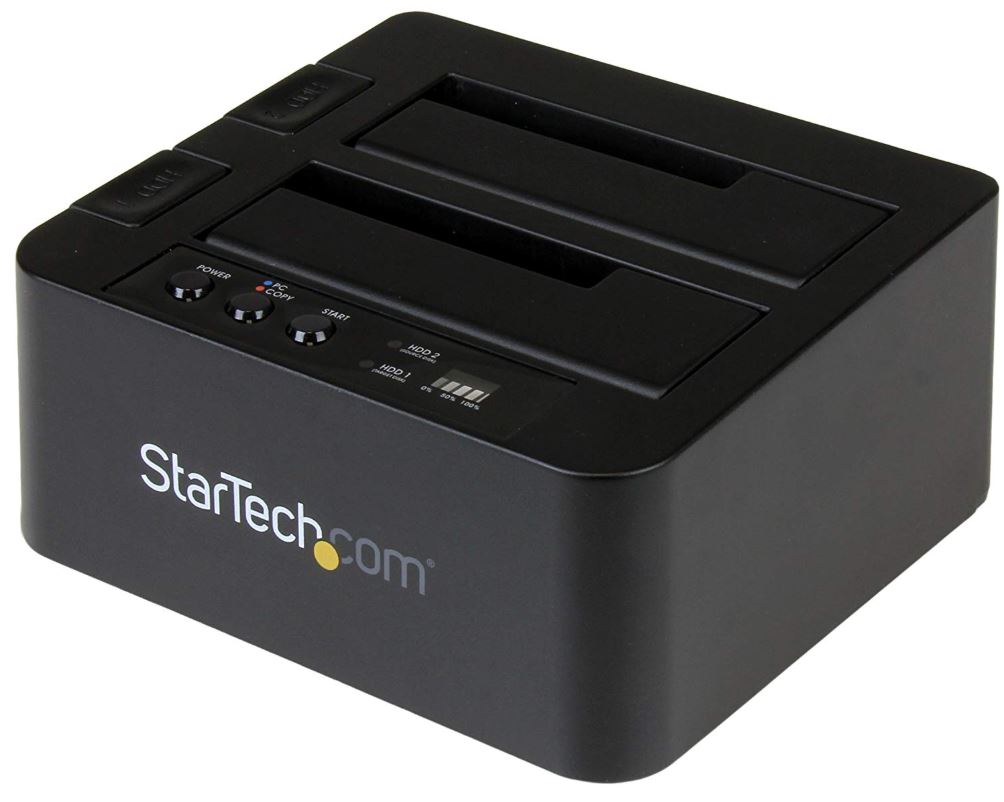
StarTech.com USB 3.1 (USB-C) Hard Drive Duplicator Dock
The StarTech.com USB 3.1 Hard Drive Duplicator Dock is a top-loading, toaster-style dock. This design makes it easy to insert and remove your drives. It can accommodate both 2.5-inch and 3.5-inch drives, including both SSDs and HDDs. Once a drive has been inserted, the dock locks it securely into place. At that point, it can only be removed by pressing the eject button. Each drive has its own eject button, which makes it easy to quickly make multiple copies of the same drive. When no drive is inserted, drive doors automatically close, preventing dirt and debris from getting into the slots. The doors also help stabilize drives that are thinner than the entire slot.
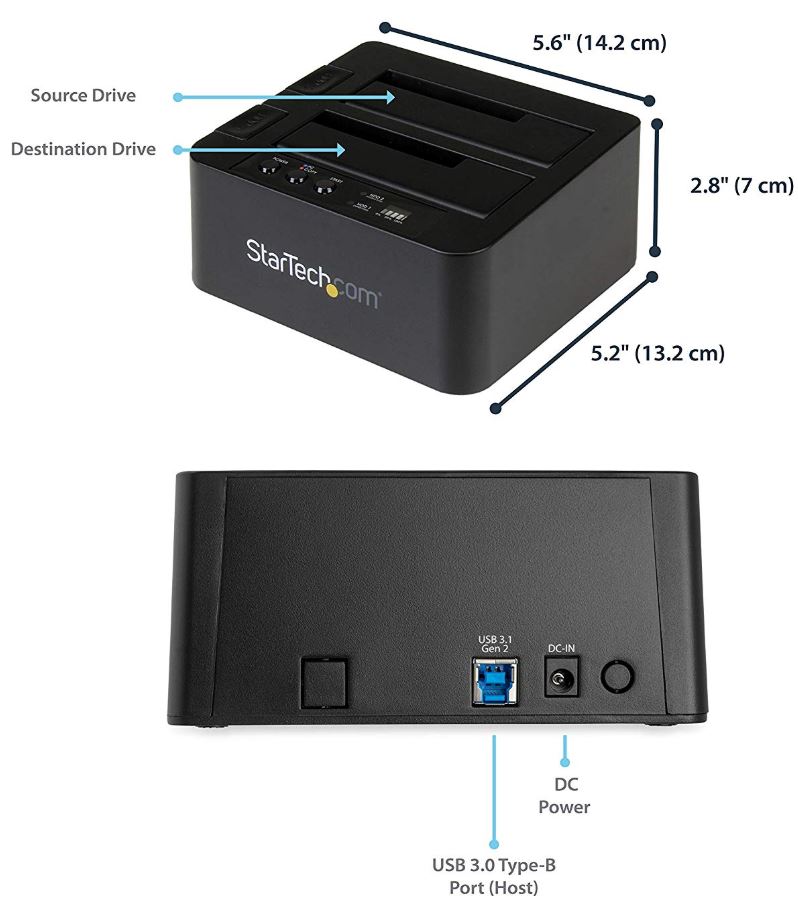
The overall dimensions are 7.3 inches deep, 8.3 inches wide, and 4.7 inches tall. Constructed from black ABS plastic, the unit weighs in at 2.2 pounds. On top, you’ll find power and copy buttons, as well as a button to switch between copying and transfer modes. There are also LEDs to indicate when each drive is inserted and fully seated. A separate LED light bar will slowly fill up as your drive copies, so you can keep track of the progress.
The StarTech.com USB 3.1 Hard Drive Duplicator Dock includes a universal power adapter. This allows you to use the dock almost anywhere in the world, with both 110/120-volt and 220/240-volt power. If you want to convert your internal drive into an external drive, connect via the USB Type-B port. The kit includes cables that connect to both standard USB and USB Type-C drives. The Type-C connector is also compatible with Thunderbolt ports.

Duplication Performance
The StarTech.com Duplicator Dock allows for exceptional duplication speeds, as fast as 28 GB per minute. At this rate, you could duplicate an entire 1TB hard drive in just over half an hour. If you have a larger hard drive, that’s not a problem. The dock has been tested with drives as large as 6TB, enough to copy just about any hard drive.
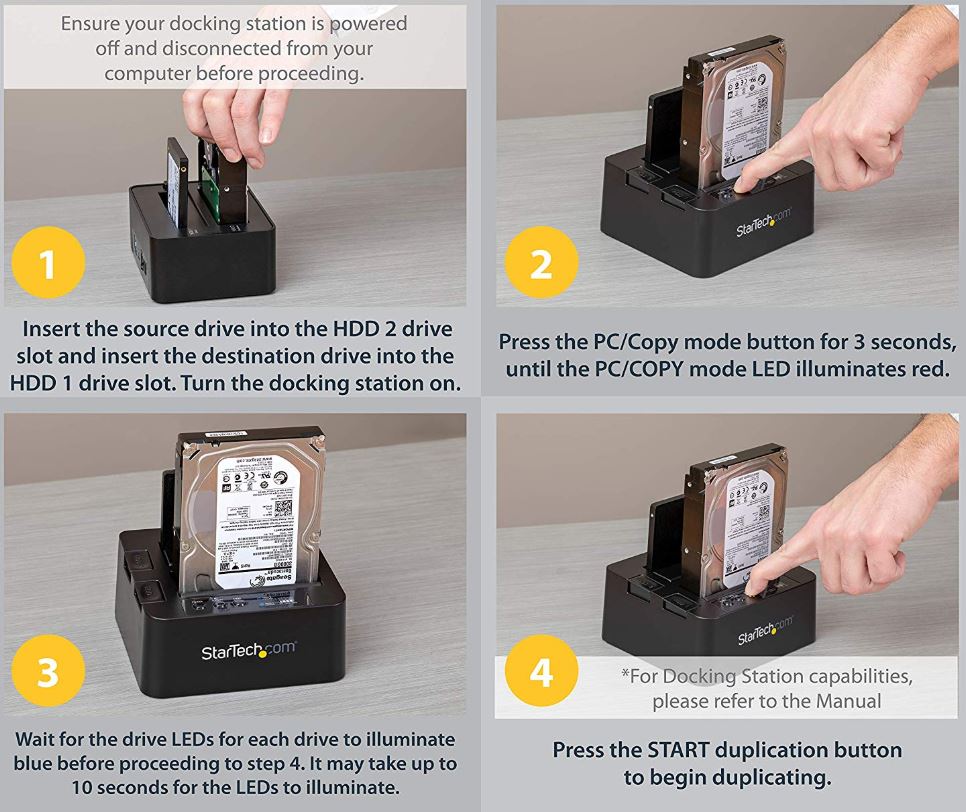
The main advantage of the StarTech.com Duplicator Dock is that it creates a perfect, sector-by-sector clone. This ensures that your partitions and boot sector will remain intact. As a result, if you want to clone a 1 TB drive onto a 3 TB drive, your partitions won’t get destroyed. This is a great added value, since many drive duplicators will cause errors when copying drives that have multiple partitions. However, sector-by-sector cloning is also useful for data recovery. Many duplicators will only copy data that’s properly listed in the drive’s directory. By copying every sector, the StarTech.com Duplicator Dock enables you to access data that was deleted or corrupted. This is a very useful tool for forensic recovery, or even for recovering deleted photos and home videos.
When using the duplicator dock for external storage, you can achieve transfer speeds as fast as 10 Gbps. This is assuming you use the USB Type-C connector. If you use the standard USB connector, your maximum speed is going to be 480 Mbps. This is the maximum speed that a USB 2.0 port can support. As a result, the StarTech.com Duplicator Dock gives you the fastest performance on the market. You can convert an internal hard drive into an external drive that performs as well as a premium external drive. If you have some old hard drives lying around, this is a great way to expand your home computer’s storage.
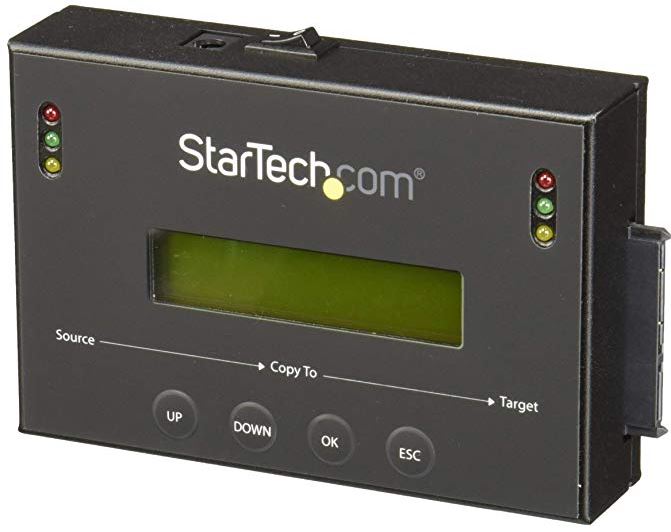
StarTech.com Standalone 2.5/3.5” SATA Hard Drive Duplicator
When compared to the StarTech.com Duplicator Dock, the StarTech.com Standalone 2.5/3.5” SATA Hard Drive Duplicator is noticeably different. It’s not a docking bay. As a result, it’s not suitable for converting an internal drive into an external drive. That said, it’s superbly suited for dealing with drives that are still mounted inside a PC. Simply disconnect your drive’s SATA cable, plug it into the StarTech.com Standalone SATA Hard Drive Duplicator, and start copying.
The Standalone SATA Hard Drive Duplicator is about the size of a deck of cards, and weighs about the same. It has male SATA connections on both sides, so you can connect it easily to two hard drives. On the front, you’ll find a small LCD display. Underneath, there’s a set of four squishy buttons. The first two allow you to navigate through the menu and choose different options. The next allow you to choose an option or back out. This allows for easy, intuitive operation. There are also LEDs on both sides, near the SATA ports. These indicate when a drive is connected, as well as when it’s actively reading or writing. On the top of the duplicator, you’ll find a power input port, as well as a simple on/off switch.

Along with the unit itself, you receive a variety of accessories to complete the package. The first of these is a universal power adapter. This allows you to connect to 110/120-volt power, as well as 220/240-volt power. You can use the StarTech.com Standalone SATA Hard Drive Duplicator in virtually every country. You also get a long SATA cable and 2 short SATA cables for connecting to internal hard drives. If you’re trying to recover an old external drive, you can use either a 12-volt or 5-volt eSATA cable. Both of these are included in the kit. You also get a pair of soft, plush pads for resting your HDDs or SSDs.
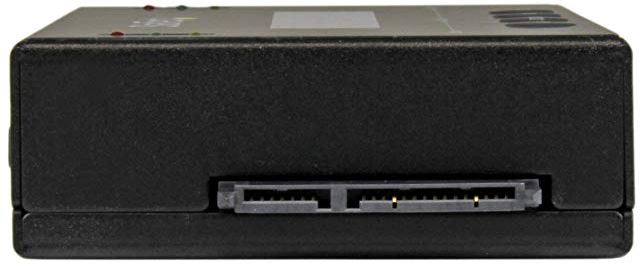
Duplication Performance
The Standalone SATA Hard Drive Duplicator is a bit slower than StarTech.com’s Duplicator Dock. The maximum transfer speeds are 6 GB per minute, which would transfer a 1 TB drive in just under 3 hours. On the other hand, you don’t have to remove your drive from your PC to perform the operation. Besides which, the SATA Hard Drive Duplicator isn’t primarily designed for data recovery. It’s designed for imaging brand new hard drives.
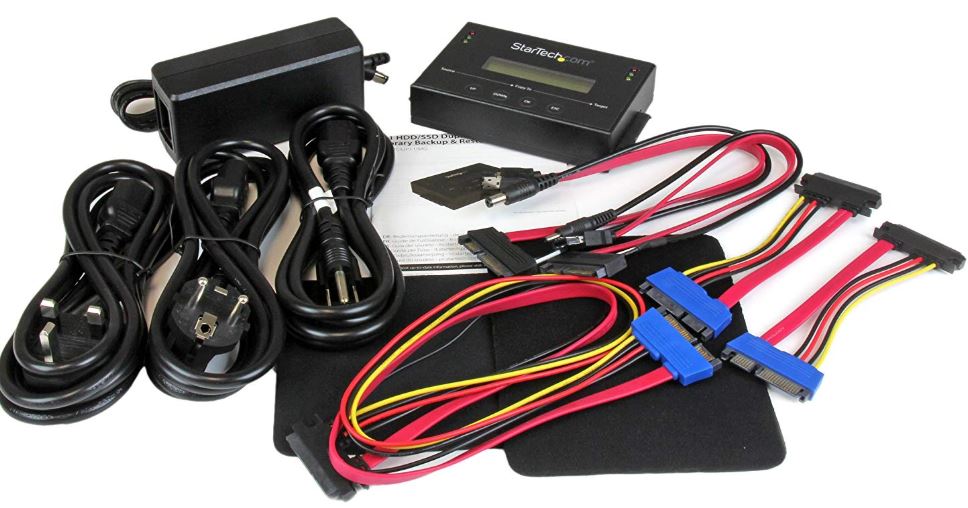
The Standalone SATA Hard Drive Duplicator is capable of selecting between multiple drive images. As a result, you can save several drive images on a single library drive on a single SSD or HDD. This makes it an ideal tool for IT professionals. For example, suppose you have a variety of standard software packages that are used by different user groups. You could store each image separately, then select between them using the SATA Hard Drive Duplicator. This makes it quick and easy to setup a number of new computers.
There are also three different modes for duplicating a single drive. The first mode is “file & system copy”. In this mode, the SATA Hard Drive Duplicator will copy all files that are in the directory on one partition. There’s also “all partitions” mode. This is similar to file & system copy mode, but it will copy data from all partitions on the drive. Finally, there’s “whole copy” mode. This mode will copy all data, including the boot sector, on a sector-by-sector basis.
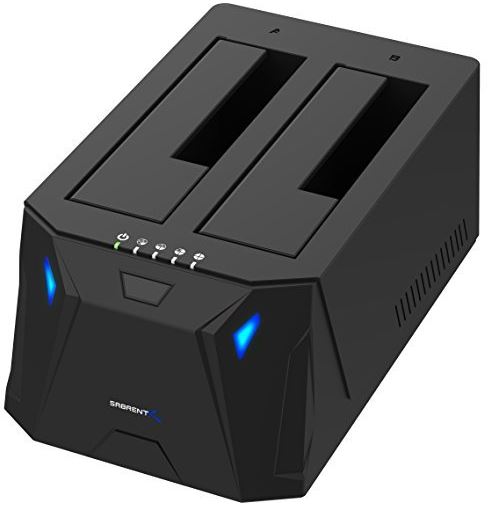
Sabrent USB 3.0 to SATA I/II/III Dual Bay External Hard Drive Docking Station
The Sabrent USB 3.0 to SATA Dual Bay External Hard Drive Docking Station is similar to the StarTech.com Docking Station. It’s a bit smaller, though, measuring 6.9 inches wide, 3.9 inches deep, and 2.7 inches thick. It weighs in at 1.19 pounds, so it’s relatively lightweight for the size. The device is constructed from black ABS plastic, with a pair of toaster-style ports on top. Each port can support both 2.5-inch and 3.5-inch drives, both SSDs and HDDs. This allows you to copy virtually any hard drive in the world.
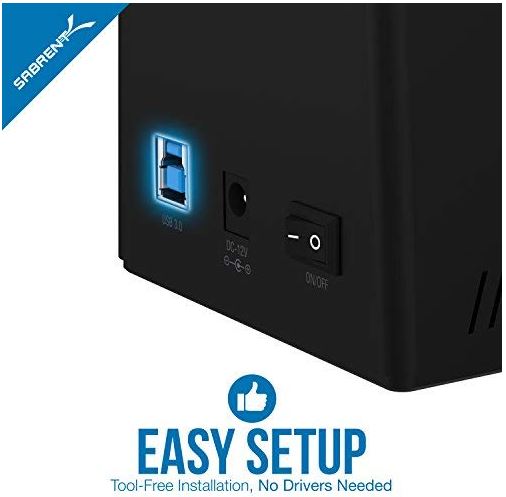
On top of the dock, you’ll see a row of four LED lights. These indicate the progress level when you’re cloning a drive. There’s also an LED to indicate that the device is powered on. On the front, there are separate, larger LEDs that let you know when a drive is inserted and connected. The docking ports themselves have doors that close automatically when a drive is removed. This will keep the inside of the ports clean. The doors are spring-loaded, so they will also support drives and keep them stable while they’re inserted.
In addition to the Sabrent dock itself, you also receive a standard 110/120-volt power supply. Keep in mind that this will only work in North America. You also get an owner’s manual, as well as a USB 3.0 cable. While the Sabrent Docking Station is capable of handling USB 3.0 speeds, it’s also compatible with USB 2.0 and 1.1.
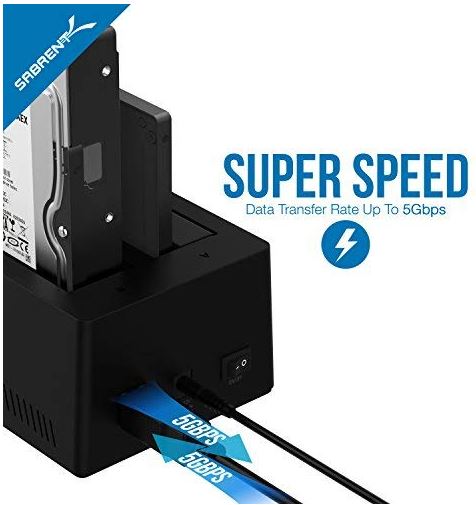
Duplication Performance
The Sabrent SATA Hard Drive Docking Station can be used either for hard drive cloning, or as an external dock. For both purposes, it supports hard drives up to 10 TB. It’s also compatible with most operating systems, including Windows, MacOS, and most Linux distributions. This makes it the most highly-compatible hard drive duplicator on our list.
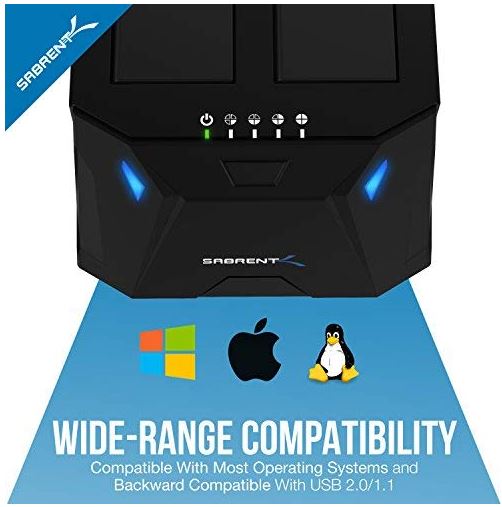
When used for cloning, it supports speeds of 60 Mbps, or about 15 MB per minute. At these speeds, you can copy a 1 TB drive in a little bit more than an hour. This is a respectable pace, but for larger drives, you’ll still need to wait overnight. For data transfer to or from your PC, the speed will depend on the speed of your PC’s USB port. On a 3.0 port, your speeds will be a respectable 5 Gbps. On a 2.0 port, your speed will still be decent, at 480 Mbps. On an older 1.1 port, your maximum speed will be 12 Mbps. That’s pretty slow. But it’s not the Sabrent Docking Station’s fault. It’s simply the limitation of older USB ports.
If you don’t have any spare internal drives, you might do better by simply buying a pre-built external drive. For example, take a look at the Sabrent Rocket Nano, which comes in 512GB, 1TB, and 2TB sizes. It also has a tough aluminum case, which makes it pretty durable.
Final Verdict
So, which one of these hard drive duplicator/cloners is the best of the bunch? As with most computer components, it depends on what exactly you’re looking for.
To begin with, the StarTech.com USB 3.1 (USB-C) Hard Drive Duplicator Dock offers the highest speeds. At 28 GB per minute, it allows for ultra-fast cloning. The sector-by-sector cloning is also a great feature, especially for data recovery. However, it can leave your drive cluttered if you’re just trying to copy a few files and folders.
The StarTech.com Standalone 2.5/3.5” SATA Hard Drive Duplicator is best for imaging. The transfer speeds are relatively slow. However, the ability to store and copy multiple images from a single library makes it a great choice for business.
Finally, the Sabrent USB 3.0 to SATA Dual Bay External Hard Drive Docking Station is the best for compatibility. It supports a variety of operating systems, making it ideal for Mac and Linux users. It also supports up to 10TB hard drives.
Meet Ry, “TechGuru,” a 36-year-old technology enthusiast with a deep passion for tech innovations. With extensive experience, he specializes in gaming hardware and software, and has expertise in gadgets, custom PCs, and audio.
Besides writing about tech and reviewing new products, he enjoys traveling, hiking, and photography. Committed to keeping up with the latest industry trends, he aims to guide readers in making informed tech decisions.

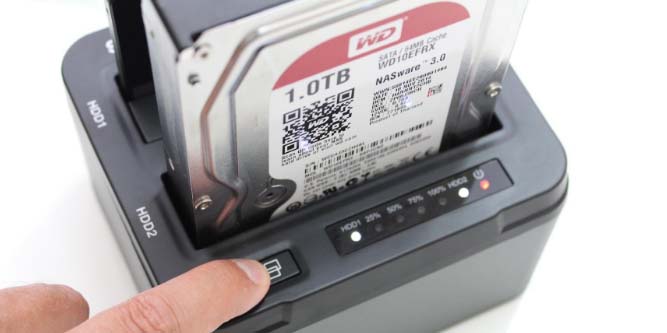
Dear sir
I need some information about your duplicator..is it possible to duplicate 3.5″ide to 3.5″ide….also 2.5 ide to 2.5 ide…2.5 to 3.5 ide…3.5 to 2.5 ide
Thank you please sdend me full specification and your offer price
Best regards
I was wondering about bad sectors on the target disk when cloning. If I am reusing a target disk in rotation, it is possible (even likely) that it has bad sectors. So during the clone, is there a potential to copy good data into a bad sector? Does the low-level copy know how to adjust for that? If not, I would hope would it at least detects the error and abort the clone job. I was looking for a low-level white paper on how this might actually work but was not able to find..
Hi
I am looking for a stand alone closer to clone my Mac hard drive with windows boot camp partition.
Could you recommend any closer that dose this?
Thanks
Kevin
Hi will any of these duplicators, duplicate/clone a windows 7 and Mac osx operating system?
Also I have a multi-boot drive that contains windows 7, osx sierra, osx el capitan, and osx Yosemite.
Will this duplicator duplicate, clone the entire drive, sector by sector to another like hard drive using any of the 3 duplicators mentioned above?
Thanks,
Michael Breskin
Photographer, and Graphics Workstation Builder
Which of the 3 products listed above is best for cloning a 1 TB mechanical HD ( only about 10% of which is used) to a 500 gb Solid State drive? Or, would any one of the 3 be suitable?
Any other stations that support 14TB? Ow what would be a solution for bigger HDs?